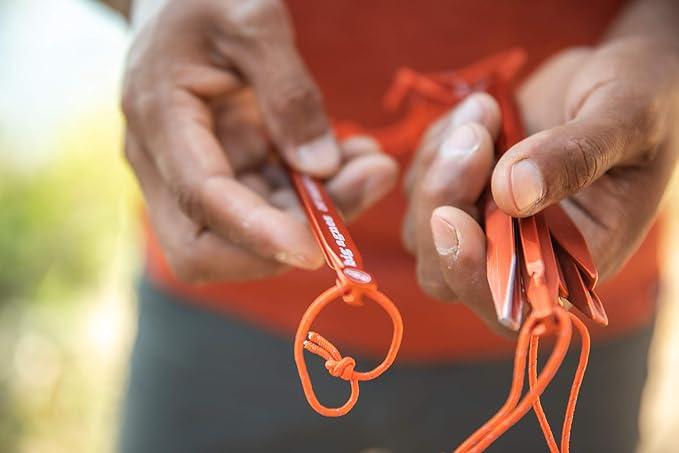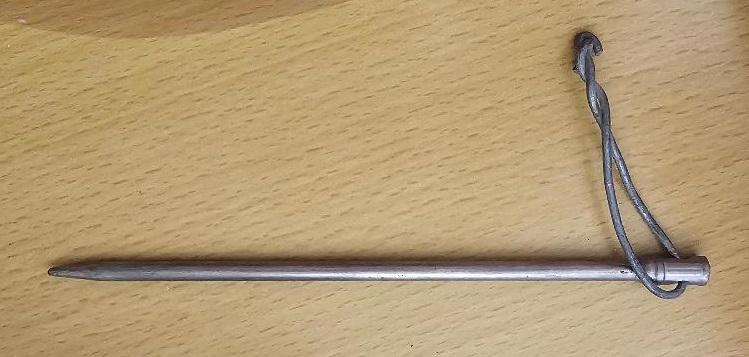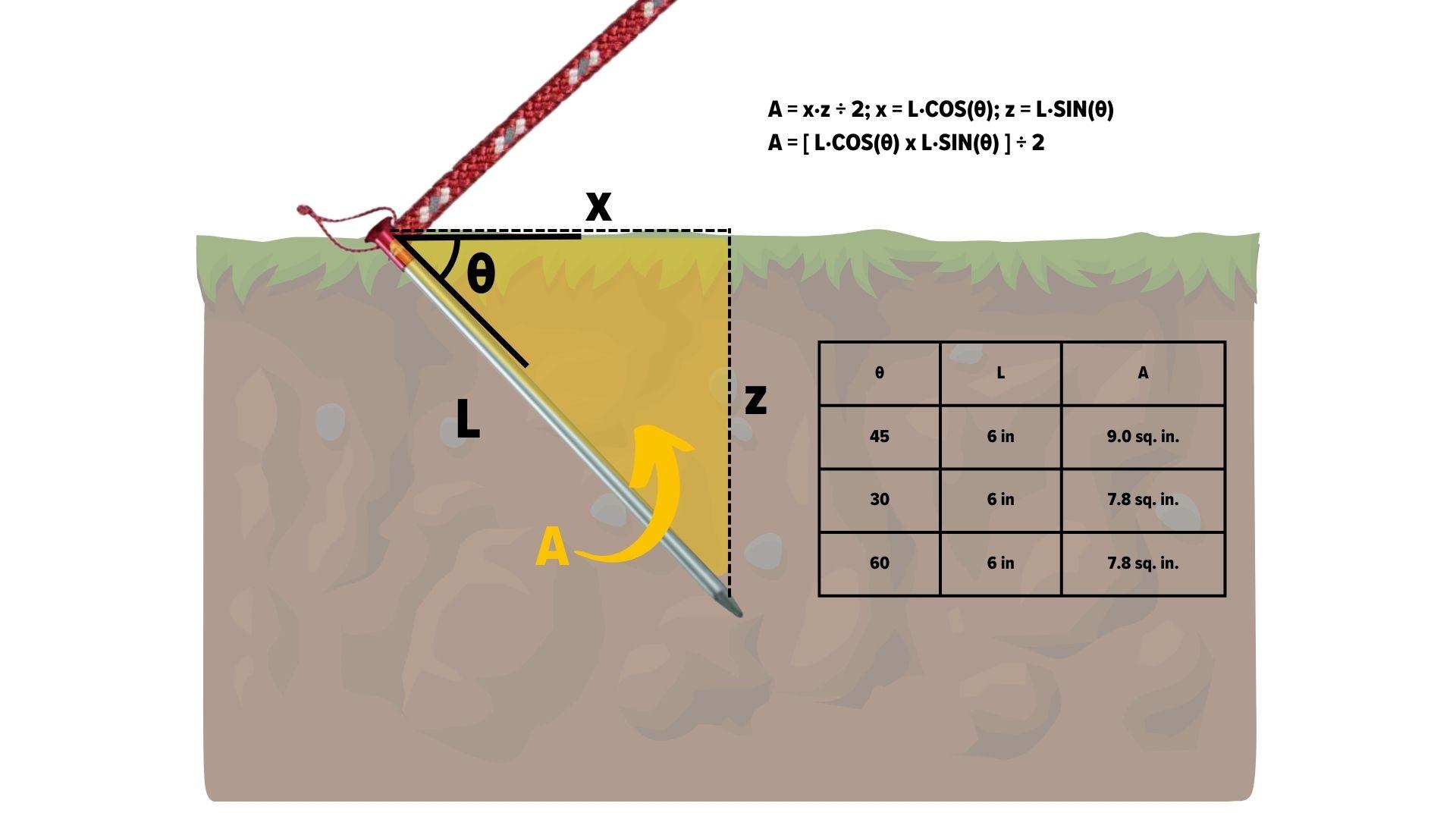Topic
How do tent stakes interact with soils to create holding power?
Forum Posting
A Membership is required to post in the forums. Login or become a member to post in the member forums!
Home › Forums › Campfire › Editor’s Roundtable › How do tent stakes interact with soils to create holding power?
- This topic has 74 replies, 28 voices, and was last updated 2 months, 2 weeks ago by
 Jerry Adams.
Jerry Adams.
-
AuthorPosts
-
Aug 5, 2024 at 9:37 pm #3816001
Companion forum thread to: How do tent stakes interact with soils to create holding power?
Tent stake holding power, especially in adverse wind conditions, relies on principles of engineering and physics, including cross-sectional shape, length, soil interaction, and insertion angle.
Aug 6, 2024 at 8:03 am #3816007Longer lines. Less angle. A 6” stake at 45*. 6 x 6 x stake width/ 2. There’s only about 4.5 cubic inches of soil holding the stake before failure.
Aug 6, 2024 at 9:00 am #3816009Longer lines certainly help. Some shelters don’t offer that option, e.g., perimeter lines on trekking pole tents where there’s a steep seam line from the trekking pole apex down to the stake-out point.
Aug 6, 2024 at 9:33 am #3816016@terran how are you estimating your soil holding volume to come up with 4.5 in^3?
Aug 6, 2024 at 10:06 am #3816022If the stake is at a 45* angle to the earth, 90* to the line, there’s direct force from the line. Ignoring the leveraging, the resistance comes from only a small triangular section of what’s mostly top soil. With leveraging, there’s actually compression of the bottom soil, or the stake bends. There’s only a small amount of soil displaced before the stake goes to straight and gets pulled out.
The length of the stake squared divided by 2 for the triangle. Then multiplied by width for volume.
Aug 6, 2024 at 10:35 am #3816025Isn’t the effective soil volume more three dimensional? If I recall correctly, the soil will break out more of a triangle shape (when looking down from the top). Does that make sense?
Aug 6, 2024 at 10:42 am #3816026The best strength/hold per weight ratio of any stake I’ve found is the new Big Agnes Dirt Dagger I- beams. Made with the highest grade 7A04 aluminum. Design isn’t a symmetrical I-beam, the back side is about 60% as wide as the face (far left stake in pic below). They come in 4 sizes: 6″ (.3 oz), 6.75″ (.46oz), 7.5″ (.65 oz) and 10″ (1.65 oz). The 7.5″ are a couple grams heavier than Groundhogs but superior in terms of strength and hold.

Another view of the I-beam (stake on left).
 Aug 6, 2024 at 10:48 am #3816027
Aug 6, 2024 at 10:48 am #3816027Fifth dimensional. Up, Up, and Away. Like a boat going through water. The path of least resistance.
Aug 6, 2024 at 10:48 am #3816028While this is not usually a concern in the hills of Pennsylvania where I do most of my hiking, I enjoyed the article – thank you. I think we all use Ti shepherd hooks – including some “classic” BPL orange painted hooks from when the BPL store was functioning. The stakes (and guylines) with each of my shelters offer an interesting timeline of what was available at that time.
I especially enjoyed the stake bag discussion – I really like having my stakes in a small bag so that I don’t lose them. Back when Lawson was making CF tarps, I had him make me a hammock tarp and had him integrate the stake bag into the outside of the tarp stuff sack. For me it was ideal – I didn’t have to worry about the stakes punching a hole in the tarp and they were easily accessible. It also made finding the stuff sack easier because I usually carried two extra stakes for additional guylines that were used only if weather conditions warranted. I wish all vendors would at least offer that as an option.
Aug 6, 2024 at 12:42 pm #3816033I get most of my line from Lawson. It holds knots well and unties easy. There’s not a lot of stretch.The 2mm is plenty strong for most uses. For stakes, I use a seal-a-meal bag.
 Aug 6, 2024 at 3:15 pm #3816044
Aug 6, 2024 at 3:15 pm #3816044Good article
I’ve been using vargo ti nail peg on 4 corners. They don’t bend like other stakes. I agree, very robust is a bit heavy.
One problem I sometimes have is it goes into a root and it is difficult to extract. I have to dig it out, then wiggle back and forth.
The cord wore out. I replaced one with #12 galvanized steel wire. Adds 0.1 ounce. Then, to remove the stake I can rotate it with the wire. Which frees the stake from the ground, then I can just pull it out.

Hmmm… that wire is pretty ugly. I need to make it look better. I stopped when it worked : )
Since the diameter of the stake is larger without being too heavy, because it’s a hollow tube, it has more friction with the ground so stays in place better.
I use old BPL orange ti shepard hook stakes for in between where there isn’t as much pull on them.
I have some groundhogs or whatever, that I found, that have three or four fins. They are harder to pull out because you can’t rotate them.
Aug 6, 2024 at 4:14 pm #3816047Side note – anyone know what the shelter in the first pic of the article is?
Aug 6, 2024 at 5:05 pm #3816048It looks like a Locus Gear Soris in DCF? https://locusgear.com/en-us/products/soris-sil
Aug 6, 2024 at 8:27 pm #3816055My biggest beef with stake bags is the colors. I love neutral color, grey or green tents, but I want my stake bag to be bright blue, with reflective accents, so it’s easy to find.
Aug 7, 2024 at 10:06 am #3816061DCF Soris…Holy guacamole! She’s a beaut.
I am also a big fan of the tubular stakes. I think the 9″ length adds significantly to the holding power and overall utility of the stakes – they are easier to wedge under or around other natural anchor points, for example.
Aug 7, 2024 at 4:19 pm #3816084When in doubt, depending on the tent, I throw a couple 8″ Big Sky Tube Steaks. These work especially well on the Tarptent Notch pitchloc ends(or any line with a steep angle and lots of tension)-the line angle is incredibly steep. Before that someone suggested adding 12-18″ of line to ease up the angle which helped quite bit but it requires that much more site space.
Aug 8, 2024 at 2:03 pm #3816123Ryan, how did you break the tips off the Big Sky stakes? That seems like a really strange failure mode.
I like the Vargo stakes also — but they will bend with sufficient force (trying to hammer through a rock, for example).
My default is the Easton or Big Sky longest version for most locations, Vargo nails for backup in the right ground conditions and for secondary staking points when I use the Duomid. I also carry a few BPL orange skewers with the Duomid for the wind flap reduction locations (anything with an elastic cord attached).
In the past, I’ve considered a trowel as a backup stake. At other times, I carried a v-stake for a trowel. I stopped doing both. if you actually need a trowel, a stake is a poor substitute — so is taking a trowel/stake out that went in because you needed it.
Aug 9, 2024 at 10:32 am #3816159<p style=”text-align: center;”>The British Delta Ground Stake is highly regarded in the soggy soils of Scotland. It gets excellent reviews, a number from American hikers needed a reliable solution. A Scottish hikers/photographer, RS outdoors and Renegade Scot on Youtube, tested it against more common stakes. The Delta held far better than others. It’s a bit of a sizable plastic thing, but likely worth it for certain conditions. RS didn’t have the means for an objective test other than leaning his body holding a cord to the stake. Then again, he was using it on peak trips to hold his Tarptent Notch secretly in strong winds. Just FYI if anyone wants to look up the Delta stake, CampingWorld.co.uk has it. Search for Delta Ground Anchor.</p>
Aug 9, 2024 at 1:57 pm #3816216Secretly = Securely
Delta Anchor 45-46g, Weight not shown on website
Aug 10, 2024 at 2:26 pm #3816264@erickammerer I took a dozen each of Tarptent, MLD, HMG, MSR, and Big Sky tubular stakes and whacked on them with the MSR stake hammer in hard ground from various angles. The MSR Core held up the best (I wasn’t able to break off any of those heads in my “normal hammer usage”, and was able to break off or loosen more than 50% of the Big Sky ones. The rest were all in the “occasional failure” range ~ 20% or less. Definitely a stress test, obviously not normal usage for most people. I think there’s some variability in glues/curing among the brands and types. In addition, the Big Sky ones are designed in a way that whacking on them creates quite a bit of concentrated stress on the end of the tube that causes the tip to loosen/break off, because there’s less reinforced material in that stake head.
Aug 10, 2024 at 2:43 pm #3816265In the Sierra, where I mostly hike, soil tends to be extremely shallow with a base of granite beneath. Sometimes at altitude, when staking you’ll get lucky and find a seam in the rock. If not, and no stake can pound in, no matter! there’s a ton of rocks around to pile on top of your stakes, when it comes to that. Very solid anchor.
I grew up hiking in the PNW. And worked for several years doing trail crew in the Olympics and north Cascades. Going back after several decades of hiking high up in the Sierra, I was reminded of how easy it was to stake a tent in soft deep soil. and how easy it is on my feet to hike on soft deep soil, rather than the rocky ground of the high Sierra!
On the other hand…oh never mind.
Aug 10, 2024 at 3:22 pm #3816266@terran I might be missing something, but here’s how I calculate the triangle area for the soil:

This model has been proposed before, with the assumption that the 45 degree orientation is “optimum” because that’s the configuration that maximizes the area A of that triangle of soil “resistance”. However, the actual load tests don’t bear this out. In fact, they are pretty poorly correlated so long as the angle between the guyline and the tent stake stays perpendicular.
If you take the extreme case where the guyline is parallel to the ground and the stake is vertical, then the triangle has to be drawn with the apexes in different locations – i.e., where do you define the location of the x-z apex intersects the ground? It will be in a different spot if the guyline is 20 degrees off the ground surface. So the triangle probably needs to be defined as a function of the relative x and z directional vectors of the force angle between the stake and guyline, because that’s not always going to be 90 degrees.
This model might be a reasonable approximation that accommodates independent stake insertion angles and guyline-to-stake angles, so if you know those two angles and the length of the stake, you can approximate the triangular area of soil resistance more effectively that reflects the force vectors that are pulling vs. levering on the stake:
 Aug 10, 2024 at 5:25 pm #3816274
Aug 10, 2024 at 5:25 pm #3816274This article spends a fair amount of time discussing soil types and makes a reasonable argument that the type of soil affects the optimal angle of stake insertion. Applying some geometry to their recommendations says an 8″ stake should be inserted with top starting 1.5 to 2 inches from vertical.
Alternatively first do a few test stake points to get a feel for the soil, stake out the shelter — and hope the soils are similar where it matters.
Aug 10, 2024 at 6:05 pm #3816276Wouldn’t LZ be 90*? ZX 45*? I came up with twice the area or 18”sq. Figuring the width of the stake at 0.25” gave me a volume of 4.5” cubed. I would think the direction of the force would be parallel to the guy line with different levels of resistance creating the levering action.
Aug 10, 2024 at 8:29 pm #3816278‘Wouldn’t LZ be 90*? ZX 45*? I came up with twice the area or 18”sq.”
geeze, I know that I do all of these calculations before pounding any individual tent stake. (eyeroll emoji here) Phew! that’s a lot of math.
thanks, Ryan, for giving us all a best angle for pitching stakes. Of course we’ll never reach mathematical perfection, but understanding what makes a best possible stake angle is significant. Most of us here have been in weather where a solid stake for our tent is crucial. Understanding how that’s best done is valuable. Maybe life saving.
-
AuthorPosts
- You must be logged in to reply to this topic.
Forum Posting
A Membership is required to post in the forums. Login or become a member to post in the member forums!
HAPPENING RIGHT NOW (February 11-21, 2025) - Shop Hyperlite Mountain Gear's Biggest Sale of the Year:
Our Community Posts are Moderated
Backpacking Light community posts are moderated and here to foster helpful and positive discussions about lightweight backpacking. Please be mindful of our values and boundaries and review our Community Guidelines prior to posting.
Get the Newsletter
Gear Research & Discovery Tools
- Browse our curated Gear Shop
- See the latest Gear Deals and Sales
- Our Recommendations
- Search for Gear on Sale with the Gear Finder
- Used Gear Swap
- Member Gear Reviews and BPL Gear Review Articles
- Browse by Gear Type or Brand.









